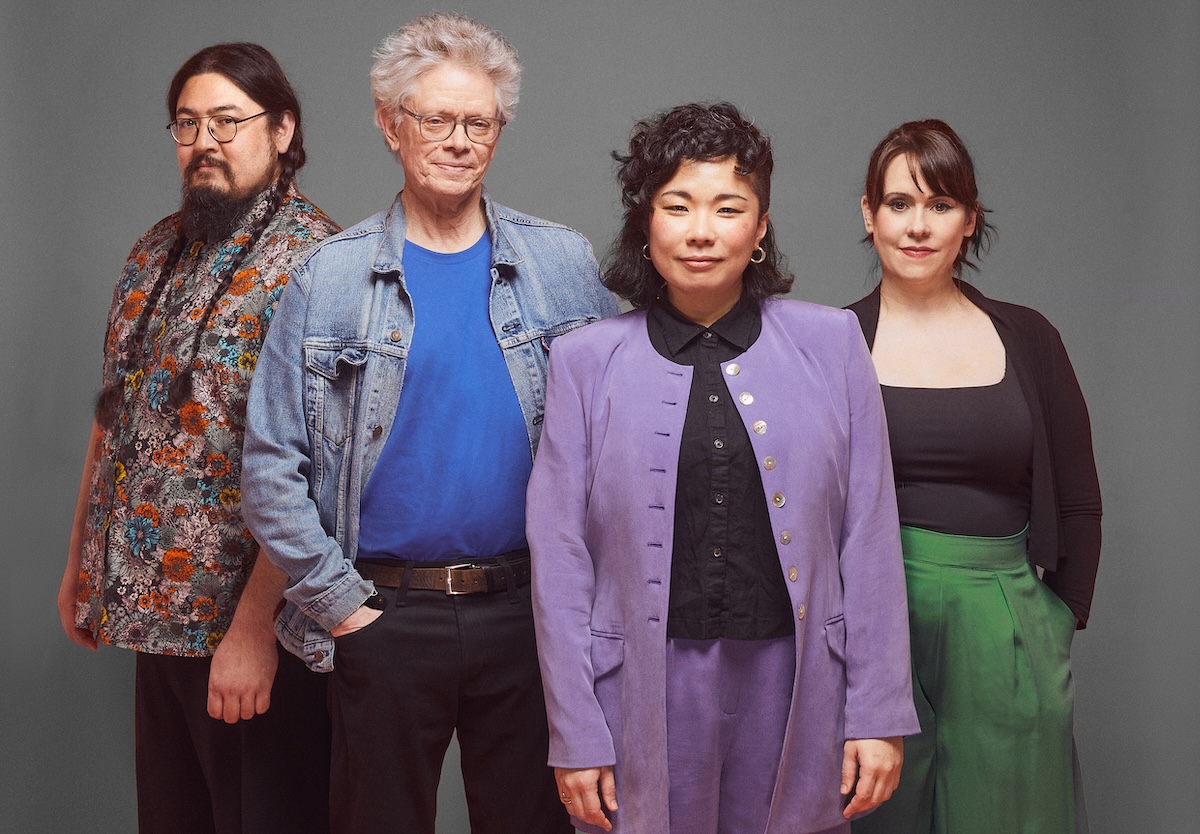
Image of the Kronos Quartet. From Left to Right: Paul Wiancko (cello), David Harrington (violin), Ayane Kozasa (viola) and Gabriela Díaz (violin). Photo Credit: Danica Taylor.
Artistic Credits
Kronos Quartet
Program
Nicole Lizée
Death to Kosmische (2010)
Death to Kosmische is a work that reflects my fascination with the notion of musical hauntology and the residual perception of music, as well as my love/hate relationship with the idea of genres. The musical elements of the piece could be construed as the faded and twisted remnants of the Kosmische style of electronic music. To do this, I have incorporated two archaic pieces of music technology (the Stylophone and the Omnichord) and have presented them through the gauze of echoes and reverberation, as well as through imitations of this technology as played by the strings. I think of the work as both a distillation and an expansion of one or several memories of music that are irrevocably altered by the impermanence of the mind. Only ghosts remain.
Nicole Lizée's Death to Kosmische was commissioned for the Kronos Quartet by Margaret Dorfman and the Ralph I. Dorfman Family Fund.
The Golden Age of the Radiophonic Workshop [Fibre-Optic Flowers] (2012)
The BBC Radiophonic Workshop in the 1960s was a place where the role of electronic music in our sound world began to take shape and, in many ways, was defined for ensuing generations. A primordial aesthetic formed around the synthetic textures that emerged from the mother(s) of invention. New sounds were needed and wanted. The technology was simple but cutting edge. Delia Derbyshire coaxed a palette of otherworldly sounds from everyday objects (a favorite being a metallic green lampshade that produced a pure ringing tone when struck). The merging of the real with the unreal (on reel-to-reel) imbued this new music with a kind of pre-digital binary sheen. Positive and negative, aligning magnetically via ferric oxide, capturing the visionary results for positronic posterity.
This piece imagines a multi-sensory world in which the beauty of the artificial is integrated with the real in an organic way. Derbyshire spoke in a magazine interview of wanting to stop and smell the fibre-optic flowers. It’s a beautiful image that aligns perfectly with The Golden Age. While the Radiophonic Workshop didn’t work with acoustic instruments in the traditional sense, this piece makes the kind of sound that might have been conjured had a string quartet been readily available. Sitting among the electronic bric-à-brac, I imagine the strings laying in wait for the moment when Delia might sneak in late at night and, in a moment of synergy, meld the wooden with the molten. The work is structured as a continuous movement where one sonic event unfurls or morphs into the next; akin to a vinyl record without track breaks. There are analogue sounds derived from hand-held proto-arcade games, turntables, reel-to-reel machines, and 4 track tape machines. Beats are played by the most analogue of data entry devices–the typewriter. In the end, these sounds all exist on equal footing as sources for musical expression in the post-Delia world.
Nicole Lizée's The Golden Age of the Radiophonic Workshop [Fibre-Optic Flowers] was commissioned for the Kronos Quartet by BBC Radio 3 and first performed by Kronos at the BBC Proms on July 24, 2012.
Black MIDI (2017)
This piece is an interpretation of the underground phenomenon known as Black MIDI. This can be defined as a microgenre that is created using Musical Instrument Digital Interface (MIDI). Music notation software and MIDI sequencers are recklessly and arbitrarily ‘blackened’ by layering thousands of notes or MIDI data. This has extended into the color world via software sequencers and drum machines.
This definition is merely the starting point for the piece. I believe the genre has potential for expansion into territory for which it was never intended. In its current state the amount of notes and speed of the notes are Black MIDI’s sole identifiers. The interpretation can be expanded to include splicing, spontaneous tempo and meter changes, metric modulation, accelerandos, extreme stretching or slowing down of material, dropped frames, pixelation, etc. Using string quartet, orchestra, and film this piece in its original version explores what Black MIDI could be: how it could be reimagined using live musicians in meticulous synchronization with film, emphasizing its inherent beauty and mysticism.
In the spirit of David Lynch, John Carpenter, and David Cronenberg, the work is constructed as a quasi-documentary or series of film shorts and/or television episodes of a fictional TV drama where each scene is set up and subsequently enhanced and manipulated by the performers. The piece tells a story of how what begins as artificially imposed MIDI commands can then spur the imagination and cross into the analogue or human world. The visuals magnify this reinterpretation, taking MIDI out of its purely data context and into an impressionistic and hallucinatory one.
Nicole Lizée’s Black MIDI was commissioned by the Toronto Symphony Orchestra, Peter Oundjian, Music Director with financial support from The Canada Council for the Arts and the Government of Canada for performances during the 150th Anniversary of the Confederation of Canada [March 2017]. The work was written for the Toronto Symphony Orchestra and the Kronos Quartet.
ZonelyHearts (2022)
Rod Serling’s Twilight Zone: a singular series brimming with imagination and creativity that left an indelible impression on its audience. The tone and messaging inherent in the series were powerful, unrelenting, and often controversial but wholly relevant; and it remains relevant - arguably more than ever - today.
ZonelyHearts does not sample content from the series but rather takes its cue from the tone and certain subject matter and messages - namely: mind control, censorship, surveillance, brainwashing, and revisionist history through altering and banning books. (These issues have a personal importance.) Perhaps its strongest message is freedom of expression and freedom to take artistic risks - both of which resonate strongly with me.
The sounds and visual elements from the Twilight Zone series have become iconic. From a compositional perspective, these elements are as appealing to me as any traditional member of the orchestra. Even Rod Serling’s voice in his narrations and introductions impart a unique timbre and musical inflection. In ZonelyHearts, specially created sounds and custom-made devices are integrated to mirror and embody the spirit of the series in my own way. Part of the joy of experiencing the TV series is its ability to surprise, and I look to convey this element in my own work.
Nicole Lizée’s ZonelyHearts was commissioned for the Kronos Quartet by Andrea Lunsford and the Middlebury Bread Loaf School of English Centennial.
All pieces in this program were written for Kronos Quartet.
For Kronos Performing Arts Association:
Ann-Marie Daniels, Managing Director
Mason Dille, Associate Director
Jackie Power, Administrative Manager
Lucinda Toy, Business Manager
Banff Centre is grateful to the following supporters for making this program possible: the Government of Alberta, the Government of Canada and the Canada Council for the Arts.







